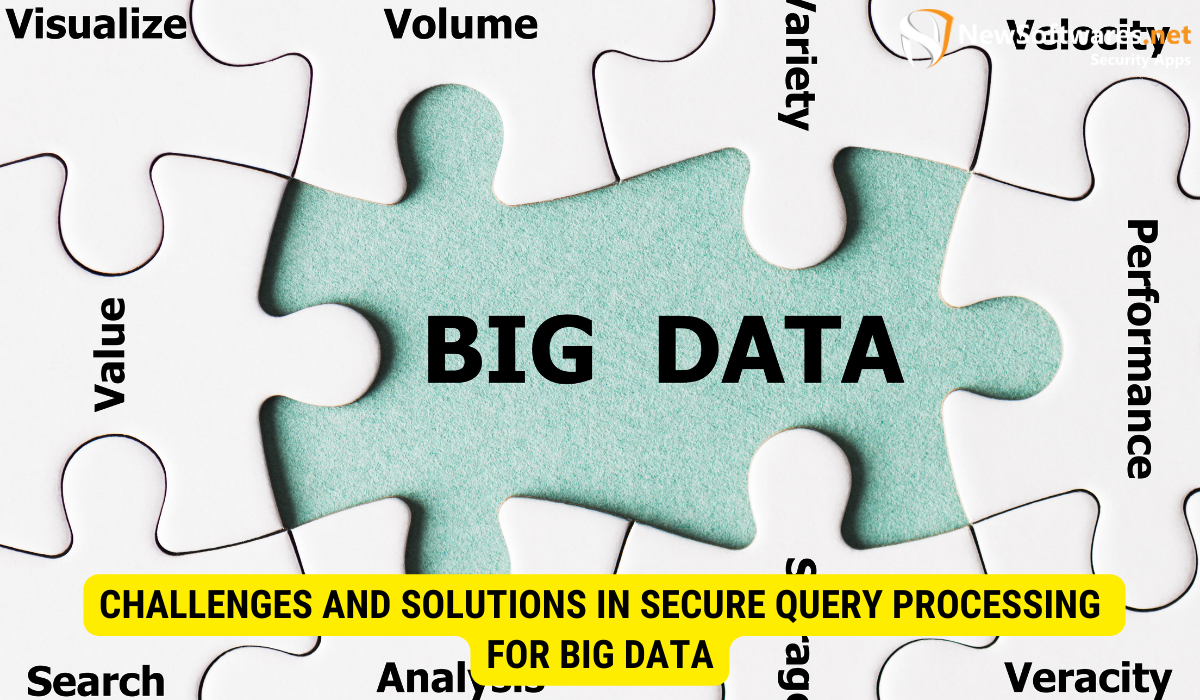Secure query processing for big data is essential for safeguarding sensitive information and complying with data privacy regulations. It involves implementing encryption, access controls, authentication, and auditing mechanisms to protect data during analysis.
In today’s digital age, the sheer volume of data generated by businesses and individuals is staggering. This influx of data, often called “Big Data,” presents opportunities and challenges. On one hand, it enables organizations to gain valuable insights and make data-driven decisions. On the other hand, it raises concerns about data security and privacy. This is where secure query processing comes into play. Together, we will delve into secure query processing for big data, exploring its importance, how it works, and its intersection with big data analysis.
Understanding the Concept of Big Data

Before diving into secure query processing, it’s crucial to clearly understand what big data entails. Big data refers to the vast and complex datasets that are beyond the capabilities of traditional data processing tools to effectively analyze and manage. Big Data is characterize by Volume, Velocity, and variety.
The evolution of technology has led to an explosion of data, with the amount of information available increasing exponentially. Big data encompass a broad range of sources and formats, from social media posts and online transactions to sensor readings and machine-generated logs.
The Evolution of Big Data
Big data has come a long way since its inception. Initially, data was primarily structured and stored in relational databases, making it relatively easy to process. However, the emergence of the internet and technological advancements paved the way for generating vast amounts of unstructured and semi-structured data.
With the proliferation of mobile devices, social media platforms, and internet-connected devices, big data has become more diverse and dynamic. Organizations across a variety of industries now have access to a profusion of data that can drive innovation and improve decision-making.
Key Components of Big Data
When it comes to big data, it’s essential to understand its key components. These components contribute to the complexity and challenges of processing and analyzing big data.
The first component is volume, which refers to the large amount of data generated daily. This includes structured data, such as customer records and financial transactions, and unstructured data, such as emails, documents, and social media posts.
The second component is velocity, which pertains to the speed at which data is generated and needs to be processed. With the advent of real-time data streaming and internet-of-things (IoT) devices, data is continuously flowing in, requiring organizations to analyze it on the fly.
The third component is variety, which encompasses the diverse types and formats of data. This includes text, images, audio, video, and more. Managing and processing these varied data types pose unique challenges, as traditional relational databases are not designed to handle such diversity.
The Importance of Secure Query Processing
As organizations harness the power of big data for data-driven insights, it’s crucial to ensure that the query processing is secure. Secure query processing refers to implementing measures to protect data during the querying and analysis.
The Role of Security in Data Analysis
Security plays a pivotal role in data analysis, as it safeguards sensitive and confidential information from illegal access, data breaches, and other cybersecurity threats. In big data, secure query processing helps address data privacy, regulatory compliance, and intellectual property protection concerns.
By implementing robust security measures, organizations can maintain the integrity of their data and build trust with their stakeholders. Secure query processing ensures that only authorized individuals can access and analyze the data, mitigating the risk of unauthorized disclosure or manipulation.
Potential Risks of Insecure Query Processing
Conversely, insecure query processing can expose organizations to significant risks and vulnerabilities. Without proper security measures, sensitive data can be compromised, resulting in reputational damage, legal consequences, and financial losses.
Some potential risks of insecure query processing include unauthorized data access, leakage, unintentional data exposure, and insider threats. These risks pose serious challenges for organizations, particularly those dealing with highly sensitive data, such as personal information, financial records, and intellectual property.
Exploring Secure Query Processing
Now that we have established the importance of secure query processing let’s delve deeper into what it entails.
Defining Secure Query Processing
Secure query processing involves implementing various security measures to protect data during the query execution. These measures aim to ensure data confidentiality, integrity, and availability throughout the querying and analysis lifecycle.
At its core, secure query processing incorporates security mechanisms into the entire data management stack, including data acquisition, storage, processing, retrieval, and visualization. It encompasses technical and organizational safeguards to address the diverse challenges big data poses.
How Secure Query Processing Works?
Secure query processing employs a combination of encryption, access controls, authentication, and auditing mechanisms to safeguard data. Let’s explore a few key components of secure query processing:
- Data Encryption: Encryption involves converting sensitive data into an unreadable format, making it unintelligible to unauthorized users. By encrypting data, organizations can ensure that the stolen information remains secure even if there is a data breach.
- Access Controls: Access controls involve determining who can access the data & what actions they can perform. By implementing granular access controls, organizations can restrict unauthorized users from querying sensitive data and perform fine-grained data filtering.
- Authentication: Authentication mechanisms verify the identity of users before granting them query access and analyze the data. This ensures that only official persons can access the data, preventing unauthorized queries and potential data breaches.
- Auditing: Auditing is crucial in secure query processing, allowing organizations to observe and track user activities. Organizations can detect and investigate suspicious or unauthorized queries by implementing comprehensive audit logging.
The Intersection of Big Data and Secure Query Processing
Secure query processing and big data are closely intertwined, with secure query processing playing a pivotal role in enabling organizations to leverage big data analytics securely.
The Need for Secure Query Processing in Big Data
As big data becomes increasingly prevalent, secure query processing becomes even more critical. Big data’s vast amount and diverse nature make it an attractive target for cybercriminals and malicious actors.
Furthermore, with the rise of data privacy regulations, for instance, the General Data Protection Regulation and the California Consumer Privacy Act, organizations are under pressure to ensure the privacy and security of their data. Secure query processing helps organizations comply with these regulations and avoid costly penalties.
The Impact of Secure Query Processing on Big Data Analysis
Secure query processing has a significant impact on big data analysis. By ensuring the security and privacy of data, organizations can confidently conduct data analysis and generate insights without compromising sensitive information.
Secure query processing also enables organizations to share data securely with partners and stakeholders, fostering collaboration and innovation. It empowers data scientists and analysts to explore and analyze big data with peace of mind, resulting in more accurate and valuable insights.
Challenges and Solutions in Secure Query Processing for Big Data

While secure query processing is essential, it comes with its own set of challenges. Let’s explore some common challenges and innovative solutions:
Common Challenges in Secure Query Processing
One of the main challenges in secure query processing is balancing security with performance. Encryption and other security measures can introduce overhead and impact query execution time. Organizations need to find a balance among security and performance to ensure efficient and timely data analysis.
Another challenge is managing access controls for large-scale big-data environments. With multiple users, vast amounts of data, and diverse data sources, organizations need robust access control mechanisms to enforce data privacy and prevent unauthorized access.
Innovative Solutions for Secure Query Processing
Organizations are adopting innovative solutions to address these challenges. One such solution is using advanced encryption techniques, such as homomorphic encryption, which allows computations to be performed on encrypted data without decrypting it.
Another solution is the adoption of fine-grained access control mechanisms, such as attribute-based access control (ABAC), that provide more granular control over data access and sharing. ABAC enables organizations to define access policies based on specific attributes, such as user roles, data sensitivity, and contextual information.
Key Takeaways
- Secure query processing ensures data confidentiality, integrity, and availability during the querying and analysis process.
- Insecure query processing can expose organizations to risks such as unauthorized data access and data leakage.
- Secure query processing involves data encryption, access controls, authentication, and auditing mechanisms to protect data.
- Secure query processing plays a crucial role in big data analysis, enabling organizations to leverage the power of big data securely.
- Challenges in secure query processing include balancing security and performance and managing access controls in large-scale big-data environments.
FAQs
Why is secure query processing important in big data analytics?
Secure query processing is important in big data analytics to protect sensitive information, comply with data privacy regulations, and mitigate the risk of data breaches and unauthorized access.
How does secure query processing work?
Secure query processing works by implementing encryption, access controls, authentication, and auditing mechanisms to safeguard data during the querying and analysis.
What are the potential risks of insecure query processing?
Potential risks of insecure query processing include unauthorized data access, data leakage, unintentional data exposure, and insider threats.
What are some innovative solutions for secure query processing?
Innovative solutions for secure query processing include advanced encryption techniques like homomorphic encryption and fine-grained access control mechanisms like attribute-based access control.
How does secure query processing impact big data analysis?
Secure query processing enables organizations to conduct data analysis securely, ensuring the privacy and integrity of data. It also facilitates secure data sharing & collaboration, providing more accurate and valuable insights.
Conclusion
In conclusion, secure query processing is essential to managing and analyzing big data. It safeguards sensitive information, ensures compliance with data privacy regulations, and mitigates the threat of data breaches. By implementing robust security measures, organizations can leverage the power of large data analytics while maintaining the privacy and integrity of their data. Secure query processing empowers organizations to unlock valuable insights and make informed decisions in today’s data-driven world.
